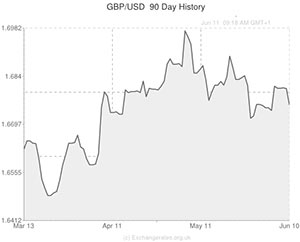
The Pound to US Dollar exchange rate (GBP/USD) traded close to 1.6800 throughout yesterday’s session as an upbeat UK manufacturing report bolstered demand for the Pound and hawkish comments from Federal Reserve Bank of St Louis President James Bullard boosted the appeal of the ‘Greenback’. It was a veritable stalemate.
The manufacturers’ association (EEF) announced that 34% of firms expect output growth to improve over the next three months, signaling that manufacturers are currently at their most optimistic since the financial crisis struck in 2007. The EEF also upgraded its forecast for manufacturing growth this year from 2.7% to 3.6%. The sanguine report was seen as a bullish signal for the Pound but GBP to USD did not respond strongly to it.
Across the pond in the United States James Bullard indicated that the Fed could start raising interest rates sooner-than-expected. The central banker said that the current prospects for GDP, inflation and the labour market are optimistic enough to warrant a rate hike by the first quarter of 2015:
“If you get 3% growth for the rest of the year, if you get unemployment coming down 6%, if you continue to have jobs growth at 200,000, if you continue to see inflation moving back up toward target, I think if we get to the fall of the year and all of those things are transpiring as I’m suggesting they will, that will change the conversation about monetary policy, and there will be more sentiment toward and earlier rate hike”.
The Pound to US Dollar exchange rate is currently positioned at an interesting pivot point. Sterling’s failed attempt at breaching longstanding resistance at 1.7000 at the start of May was seen as the end to GBP/USD’s 6-month bullish run. However, the Pound’s predicted disintegration towards 1.6600/1.6300 has not materialised as of yet. This suggests that there is potential for Sterling to rally again.
Later this morning UK industrial production is predicted to print at 0.4% for April, which would mark a strong rebound from the -0.1% contraction registered in March. If the data prints inline with economists’ forecasts then it is likely to underpin demand for the Pound as investors upgrade their second quarter GDP projections.
Tomorrow, in what is potentially a much more important economic release, British unemployment is forecast to slide from 6.8% to a fresh 5-year low of 6.7%. This could send Sterling higher versus the US Dollar because it could cause markets to reevaluate their Bank of England rate hike predictions.
However, it is hard to see GBP to USD overcoming technical resistance at 1.6920 during this week’s session because the ‘Greenback’ is likely to derive support from a sales report on Thursday, which is expected to show that retail sales accelerated by 0.6% during May.
Updated: 16:45 GMT 10/06/2014
As the European session drew to a close on Tuesday the Pound to US Dollar pairing was 0.29 per cent softer.
Although the Pound was supported against several of its peers as a result of upbeat UK industrial production and initial growth figures, the British asset failed to rally against the ‘Greenback’.
US data showed that JOLTs job openings (Fed Chairwoman Janet Yellen’s favoured employment measure) rose by more than forecast in April, climbing from a positively revised 4166 in March to 4455 the following month. A reading of 4050 had been anticipated.
Separate US data showed an increase in wholesale inventories.
Inventories rose by 1.1 per cent in April, month-on-month, almost double the 0.6 per cent increase anticipated. Wholesale trade sales also climbed by more than anticipated, jumping 1.3 per cent instead of 0.9 per cent.
Of course the main reason for the US Dollar’s bullish relationship with the Pound is that this week’s advanced US retail sales report is expected to show that sales rallied by 0.6 per cent in May.
That being said, the GBP to USD exchange rate could put on a more impressive performance tomorrow if the UK’s employment report impresses.
Update for GBP to USD – 11/06/14
Pound Sterling advanced to a session high against the US Dollar on Wednesday after data showed that unemployment in the UK fell to its lowest level in five years, boosting expectations that the Bank of England will announce an interest rate increase soon.
According to the Office for National Statistics, the UK’s jobless rate fell to 6.6% in the three months up to April, it was the lowest figure recorded since the early part of 2009.
Economists had been forecasting a decline to 6.7%.
“Over the next few months we’re expecting the rate to head down, possibly to 6%”, said an economist at the London based Santander SA.
Wage growth however disappointed as weekly earnings rose by just 0.7% in the three months to April, still well below inflation, which hit 1.8% in April.
Against the Euro the Pound hit its highest level since December 2012.
US Dollar (USD) Exchange Rates
[table width=”100%” colwidth=”50|50|50|50|50″ colalign=”left|left|left|left|left”]
Currency, ,Currency,Rate ,
US Dollar, ,Pound Sterling,0.5968,
,Pound Sterling,0.5968,
US Dollar, ,Canadian Dollar,1.0910,
,Canadian Dollar,1.0910, 
US Dollar, ,Euro,0.7386,
,Euro,0.7386,
US Dollar, ,Australian Dollar,1.0679,
,Australian Dollar,1.0679,
US Dollar, ,New Zealand Dollar,1.1752,
,New Zealand Dollar,1.1752,
Canadian Dollar, ,US Dollar ,0.9171,
,US Dollar ,0.9171,
Pound Sterling, ,US Dollar,1.6761,
,US Dollar,1.6761,
Euro, ,US Dollar,1.3549,
,US Dollar,1.3549,
Australian Dollar, ,US Dollar,0.9363,
,US Dollar,0.9363,
New Zealand Dollar, ,US Dollar,0.8512,
,US Dollar,0.8512,
[/table]

Comments are closed.